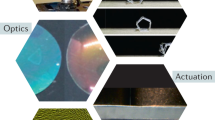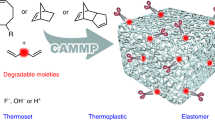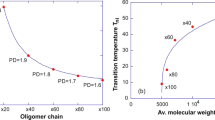Abstract
The effects of the cyclic molecules within polyrotaxanes moving over axial molecules serving as cross-linking points in a polymeric network preclude observation of the cyclic effects in polymer networks composed of conventional cross-linking agents. As a result, polymer networks with movable cross-linking points behave more gently and stretch better than conventional polymer networks. These polymer networks can be composed of various polymers when using cross-linkers obtained by modifying the vinyl groups on the polyrotaxanes. In this study, the effects of the polyrotaxane cross-linker concentration and solvent content on elastomer preparation were investigated to obtain elastomers with high toughnesses due to the properties of the polyrotaxane cross-linking agent. If elastomers were prepared in a state in which the cyclic effect of the polyrotaxane was easily expressed by the concentration of the polyrotaxane cross-linker and the amount of solvent, the elastomers obtained elongated more and were tougher than elastomers made from conventional cross-linkers.
This is a preview of subscription content, access via your institution
Access options
Subscribe to this journal
Receive 12 print issues and online access
$259.00 per year
only $21.58 per issue
Buy this article
- Purchase on Springer Link
- Instant access to full article PDF
Prices may be subject to local taxes which are calculated during checkout






Similar content being viewed by others
References
Harada A, Li J, Kamachi M. The molecular necklace - a rotaxane containing many threaded alpha-cyclodextrins. Nature. 1992;356:325–7.
Li J, Harada A, Kamachi M. Sol-gel transition during inclusion complex-formation between alpha-cyclodextrin and high-molecular-weight poly(ethylene glycol)s in aqueous-solution. Polym J. 1994;26:1019–26.
Okumura Y, Ito K. The polyrotaxane gel: a topological gel by figure-of-eight cross-links. Adv Mater. 2001;13:485.
Koyanagi K, Takashima Y, Yamaguchi H, Harada A. Movable cross-linked polymeric materials from bulk polymerization of reactive polyrotaxane cross-linker with acrylate monomers. Macromolecules. 2017;50:5695–700.
Ikura R, Kajimoto K, Park J, Murayama S, Fujiwara Y, Osaki M, et al. Highly stretchable stress-strain sensor from elastomer nanocomposites with movable cross-links and ketjenblack. Acs Polym Au. 2023;3:394–405.
Jiang YW, Zhang ZT, Wang YX, Li DL, Coen CT, Hwaun E, et al. Topological supramolecular network enabled high-conductivity, stretchable organic bioelectronics. Science. 2022;375:1411.
Sasaki Y, Nishizawa Y, Watanabe T, Kureha T, Uenishi K, Nakazono K, et al. Nanoparticle-based tough polymers with crack-propagation resistance. Langmuir. 2023;39:9262–72.
Fujita H, Ooya T, Yui N. Thermally-responsive properties of a polyrotaxane consisting of β-cyclodextrins and a poly(ethylene glycol)-poly(propylene glycol) triblock-copolymer. Polym J. 1999;31:1099–104.
Ito K. Novel cross-linking concept of polymer network: synthesis, structure, and properties of slide-ring gels with freely movable junctions. Polym J. 2007;39:489–99.
Bin Imran A, Seki T, Kataoka T, Kidowaki M, Ito K, Takeoka Y. Fabrication of mechanically improved hydrogels using a movable cross-linker based on vinyl modified polyrotaxane. Chem Commun. 2008:41:5227–9.
Bin Imran A, Esaki K, Gotoh H, Seki T, Ito K, Sakai Y, et al. Extremely stretchable thermosensitive hydrogels by introducing slide-ring polyrotaxane cross-linkers and ionic groups into the polymer network. Nat Commun. 2014;5:5124.
Gotoh H, Liu C, Bin Imran A, Hara M, Seki T, Mayumi K, et al. Optically transparent, high-toughness elastomer using a polyrotaxane cross-linker as a molecular pulley. Sci Adv. 2018;4:eaat7629.
Ohmori K, Abu Bin I, Seki T, Liu C, Mayumi K, Ito K, et al. Molecular weight dependency of polyrotaxane-cross-linked polymer gel extensibility. Chem Commun. 2016;52:13757–9.
Bin Imran A, Seki T, Takeoka Y. Recent advances in hydrogels in terms of fast stimuli responsiveness and superior mechanical performance. Polym J. 2010;42:839–51.
Araki J, Kataoka T, Ito K. Preparation of a “sliding graft copolymer”, an organic solvent-soluble polyrotaxane containing mobile side chains, and its application for a crosslinked elastomeric supramolecular film. Soft Matter. 2008;4:245–9.
Tanaka M, Sato K, Kitakami E, Kobayashi S, Hoshiba T, Fukushima K. Design of biocompatible and biodegradable polymers based on intermediate water concept. Polym J. 2015;47:114–21.
Wu C, Zhou SQ. Laser-light scattering study of the phase-transition of poly(n-isopropylacrylamide) in water .1. Single-chain. Macromolecules. 1995;28:8381–7.
Flory PJ. Principles of polymer chemistry. Ithaca, Cornell University Press; 1953.
Gent AN, Tobias RH. Threshold tear strength of elastomers. J Polym Sci Part B Polym Phys Ed. 1982;20:2051–8.
Mayumi K. Molecular dynamics and structure of polyrotaxane in solution. Polym J. 2021;53:581–6.
Kobayashi Y. Precise synthesis of polyrotaxane and preparation of supramolecular materials based on its mobility. Polym J. 2021;53:505–13.
Endo H, Mayumi K, Osaka N, Ito K, Shibayama M. The static structure of polyrotaxane in solution investigated by contrast variation small-angle neutron scattering. Polym J. 2011;43:155–63.
Yamada S, Sanada Y, Tamura A, Yui N, Sakurai K. Chain architecture and flexibility of α-cyclodextrin/peg polyrotaxanes in dilute solutions. Polym J. 2015;47:464–7.
Oya T, Enoki T, Grosberg AY, Masamune S, Sakiyama T, Takeoka Y, et al. Reversible molecular adsorption based on multiple-point interaction by shrinkable gels. Science. 1999;286:1543–5.
Alvarez-Lorenzo C, Guney O, Oya T, Sakai Y, Kobayashi M, Enoki T, et al. Polymer gels that memorize elements of molecular conformation. Macromolecules. 2000;33:8693–7.
Acknowledgements
This work was supported by the Izumi Science and Technology Foundation.
Author information
Authors and Affiliations
Contributions
The paper was written with contributions from all the authors, and all the authors have approved the final version of the paper. YT conceived and directed the project. SL, TH and YT performed the experiments and analyzed the results.
Corresponding author
Ethics declarations
Conflict of interest
The authors declare no competing interests.
Additional information
Publisher’s note Springer Nature remains neutral with regard to jurisdictional claims in published maps and institutional affiliations.
Rights and permissions
Springer Nature or its licensor (e.g. a society or other partner) holds exclusive rights to this article under a publishing agreement with the author(s) or other rightsholder(s); author self-archiving of the accepted manuscript version of this article is solely governed by the terms of such publishing agreement and applicable law.
About this article
Cite this article
Liu, S., Hayashi, T., Hara, M. et al. Optimal conditions for the use of polyrotaxane as a cross-linker in preparing elastomers with high toughnesses. Polym J (2024). https://doi.org/10.1038/s41428-024-00896-8
Received:
Revised:
Accepted:
Published:
DOI: https://doi.org/10.1038/s41428-024-00896-8



